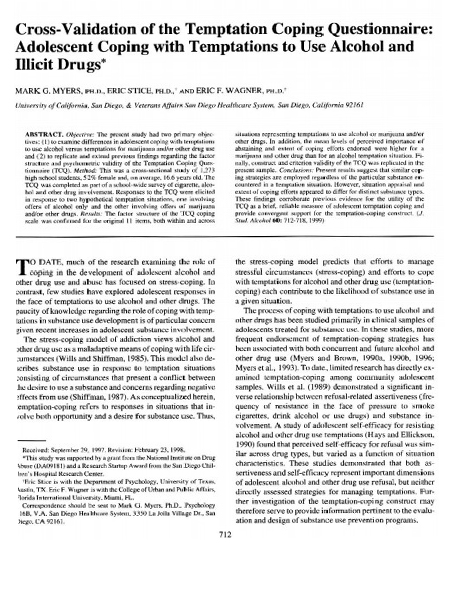Cross-validation of the Temptation Coping Questionnaire: Adolescent coping with temptations to use alcohol and illicit drugs
 Abstract: The present study had two primary objectives: (1) to examine differences in adolescent coping with temptations to use alcohol versus temptations for marijuana and/or other drug use and (2) to replicate and extend previous findings regarding the factor structure and psychometric validity of the Temptation Coping Questionnaire (TCQ). This was a cross-sectional study of 1,273 high school students, 52% female and, on average, 16.6 years old. The TCQ was completed as part of a school-wide survey of cigarette, alcohol and other drug involvement. Responses to the TCQ were elicited in response to two hypothetical temptation situations, one involving offers of alcohol only and the other involving offers of marijuana and/or other drugs. The factor structure of the TCQ coping scale was confirmed for the original 11 items, both within and across situations representing temptations to use alcohol or marijuana and/or other drugs. In addition, the mean levels of perceived importance of abstaining and extent of coping efforts endorsed were higher for a marijuana and other drug than for an alcohol temptation situation. Finally, construct and criterion validity of the TCQ was replicated in the present sample. Present results suggest that similar coping strategies are employed regardless of the particular substance encountered in a temptation situation. However, situation appraisal and extent of coping efforts appeared to differ for distinct substance types. These findings corroborate previous evidence for the utility of the TCQ as a brief, reliable measure of adolescent temptation coping and provide convergent support for the temptation-coping construct.
Abstract: The present study had two primary objectives: (1) to examine differences in adolescent coping with temptations to use alcohol versus temptations for marijuana and/or other drug use and (2) to replicate and extend previous findings regarding the factor structure and psychometric validity of the Temptation Coping Questionnaire (TCQ). This was a cross-sectional study of 1,273 high school students, 52% female and, on average, 16.6 years old. The TCQ was completed as part of a school-wide survey of cigarette, alcohol and other drug involvement. Responses to the TCQ were elicited in response to two hypothetical temptation situations, one involving offers of alcohol only and the other involving offers of marijuana and/or other drugs. The factor structure of the TCQ coping scale was confirmed for the original 11 items, both within and across situations representing temptations to use alcohol or marijuana and/or other drugs. In addition, the mean levels of perceived importance of abstaining and extent of coping efforts endorsed were higher for a marijuana and other drug than for an alcohol temptation situation. Finally, construct and criterion validity of the TCQ was replicated in the present sample. Present results suggest that similar coping strategies are employed regardless of the particular substance encountered in a temptation situation. However, situation appraisal and extent of coping efforts appeared to differ for distinct substance types. These findings corroborate previous evidence for the utility of the TCQ as a brief, reliable measure of adolescent temptation coping and provide convergent support for the temptation-coping construct.
Myers, M.G., Stice, E., & Wagner, E.F. (1999). Cross-validation of the Temptation Coping Questionnaire: Adolescent coping with temptations to use alcohol and illicit drugs. Journal of Studies on Alcohol, 60(5), 712-718. doi:10.15288/jsa.1999.60.712
